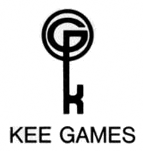 | |
| Industry | Video game industry |
|---|---|
| Founded | 1973 |
| Defunct | 1978 |
| Headquarters | US |
| Products | Arcade games |
| Owner | Joe Keenan |
| Parent | Atari, Inc. |

Kee Games was an American arcade game manufacturer that released arcade and video games from 1973 to 1978.
History
Kee was formed by Joe Keenan, a friend and neighbor of Atari co-founder Nolan Bushnell, in September 1973. In reality, Bushnell had worked with Keenan to create Kee Games in response to the pinball and arcade distributors of the time who demanded exclusivity deals; Bushnell believed that Kee Games could offer similar but renamed arcade games, or "clones", to distributors, which would greatly expand Atari's distribution beyond the limits of these deals.[1] Bushnell assigned several of Atari's staff to work at Kee Games, including Steve Bristow, Bill White, and Gil Williams, and discreetly supplied them the parts for which they could make their games.[2] To the public, Kee Games advertized itself as a competitor to Atari and that it was hiring defectors from Atari.[3]
Through 1973 and 1974, Kee's games were slight modifications of Atari games already released or games that had been left in development at Atari. These included Elimination which was based on Bristow's Quadrapong that he had left unfinished at Atari, while Spike was based on Atari's Rebound but with an added move. Kee wanted to avoid the stigma of simply being a follower of Atari and started developing its own games, its first own game being Tank that was released in November 1974.[2] Ahead of Tank's release, Atari itself was having financial and management problems. Among other measures, Atari opted to formally merge Kee Games into Atari in September 1974, with Keenan named to president of Atari and the Kee Games kept as a separate operating division.[2] Tank became a popular arcade game, and helped Atari recover from the financial downturn. Kee continued to produce arcade games through 1978, when the division was closed down by Warner Communications, which had acquired Atari in 1976.[2] After Bushnell left Atari in December 1978, Keenan departed the company a few months later, joining Bushnell to help manage his Pizza Time Theatre restaurant/arcade franchise.[2]
Games
- Elimination (October 1973) — cloned by Atari's Quadrapong
- Spike (March 1974) — a clone of Atari's Rebound, with an extra button labeled "spike"
- Formula K (April 1974) — a clone of Atari's Gran Trak 10
- Twin Racer (July 1974) — a clone of Atari's Gran Trak 20
- Tank (November 1974) — an original game that became very popular
- Pursuit (January 1975)
- Indy 800 (April 1975)
- Tank II (May 1975) — the first game sold under the "Kee" label with the Atari disclosure
- Quiz Show (April 1976)
- Tank 8 (April 1976)
- Indy 4 (May 1976)
- Sprint 2 (November 1976)
- Drag Race (June 1977)
- Super Bug (September 1977)
- Sprint 1 (January 1978)
- Ultra Tank (February 1978)
References
- ^ Perry, Tekla S. (November 2016). "Tales of Atari: New Stories of a Legendary Company Come to Light (online extended version)". IEEE Spectrum. New York, New York: Institute of Electric and Electronics Engineers. 53 (11): 24. doi:10.1109/MSPEC.2016.7607020. S2CID 37352766.
- ^ a b c d e Goldberg, Marty; Vendel, Curt (2012). "Intermission: Growing Pains". Atari Inc: Business is Fun. Sygyzy Press. ISBN 978-0985597405.
- ^ "Video Game Timeline". Electronic Gaming Monthly. No. 102. Ziff Davis. January 1998. p. 116.
Sources
External links
- Entry at Killer List of Videogames
- Entry Archived 2011-06-07 at the Wayback Machine at Arcade Flyers

